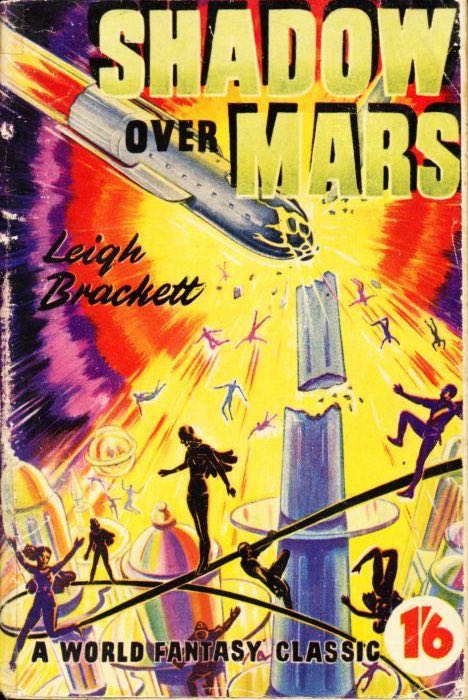Shadow Over Mars
Reviewed date: 2020 Aug 9
Rating: 3
128 pages
Also published as The Nemesis from Terra
I read Shadow Over Mars when I saw that it won the 2020 Retro Hugo for Best Novel, beating Land of Terror by Edgar Rice Burroughs. The award was for works that would have been eligible in 1945, if the Worldcon had awarded Hugos that year.
Shadow Over Mars is better than Land of Terror, which, although I do like Edgar Rice Burroughs, is a deeply unsatisfying book with a lot of problems.
Shadow Over Mars feels like an Edgar Rice Burroughs Barsoom novel with some Andre Norton thrown in. I prefer Barsoom, but this isn't bad.
Brackett writes evocatively, but relies way too often on one particular writing trick: instead of telling us what happens, she evocatively describes the effects. It's very much like she's drawing our attention to a scene.
For example, in the opening scene, Rick shoots three bad guys. But here's how Brackett describes the scene:
Rick’s left hand rose and steadied. Harsh echoes rolled and slammed between the packed, still rows of houses. Two of the shadows fell without a sound. The third stood upright in a shaft of Phobos-light and screamed.
No mention of a gun. We have to infer it from the motion of Rick's hand and the "harsh echoes" that come immediately after. Brackett never even says these "shadows" are people--again, we have to infer it. She does this constantly, at every key moment of action. She never tells us what happens, just obliquely describes the scene and makes us fill in the gaps.
Here's another example, where Jaffa Storm assassinates Ed Fallon in his office.
[Fallon's] movement, when it came, was very quick. Jaffa Storm was a little quicker. The blaster echoes faded quickly into the soundproofing. There was a seared spot on a pillar next to Storm’s head. Fallon still sat behind the desk. He had now neither a face nor any further interest in the future of his Company.
Before this little scene, Storm and Fallon were talking, and neither had a blaster. And notice that Brackett never says either man drew a weapon, or that either man shot at the other, or even that Fallon is dead. All she says is "blaster echoes faded." She doesn't say Fallon is dead, just that he has no face or any interest in his Company. It's not hard to figure out, but it's aggravating when Every. Single. Important. Scene. is written obliquely this way.
Here's another one, which I couldn't quite figure out.
Beudach snarled and got his hands around [the dwarf's] throat. Suddenly, out in the vaulted halls beyond the bronze doors of the throne room, a man screamed. And as though that sound were the trigger, a perfect fury of noise burst out.
Every man in the throne room came to his feet. No one spoke. Blades flashed out of scabbards. Beudach raised his head, and between his wide-spread feet the heels of the dwarf drummed a diminishing tattoo and were silent.
Beudach dropped the body.
Beudach killed the dwarf, I think, but this is a little too oblique for me. What does it mean when the "dwarf drummed a diminishing tattoo"? Did Beudah kill him by strangling him? Why raise his head?
And that writing trick of obliquely writing around the action instead of actually telling us? That was only in the first part of the book. She doesn't use it at all in the second half.
!!!! Jaffa Storm can read minds. He's reading Rick's mind, learning his secret plan to overthrow Jaffa Storm and the Terran Exploitations Company.
The giant mud-worms remind me an awful lot of sandworms from Dune, but Leigh Brackett's mud-worms came first.
Unlike with A Princess of Mars, I didn't feel like I got a real introduction to Mars. Rick led a revolution on Mars, and traveled around, but he was never part of Mars like John Carter was of Barsoom. Rick falls in love with an Earth woman, Mayo McCall; John Carter's love is the Martian princess Dejah Thoris. On Barsoom we learn the details of Helium and its enemies, whereas here we barely know who the Martians are--a few city-states, a few names, but no real idea how anything works.
All this to say, whereas in A Princess of Mars I felt like I was transported to Barsoom, here I was watching a space rat right for survival on a backward planet. A Princess of Mars is about Barsoom--John Carter becomes part of Barsoom. Shadow Over Mars is about Rick; he breaks some things on Mars and leaves.
Overall, I liked it and I want to read more. Leigh Brackett's Mars is the first one I've read (besides N. P. B. Barker's Kanthor) that reminds me of Barsoom.
Some links:
The Nemesis From Terra (aka Shadow Over Mars) [glorioustrash.blogspot.com]
Retro Review: “Shadow Over Mars” a.k.a. “The Nemesis from Terra” by Leigh Brackett [corabuhlert.com]
Native Martian races include:
Anthropoids
Little winged people (Kyra is one)
Humans (are they another human race? Or originally from Earth? Unsure about this.)
The Thinkers
Characters
Rick (Richard Gunn Urquhart)
Mayo McCall
Ed Fallon (Terran Exploitations Company)
Jaffa Storm (Terran Exploitations Company)
Kyra
Beudach (Chief of the fighting men of Ruh)
Haral (young Martian King of Ruh)
Parras
Hugh St. John (Earthman, Union Party)
Eran Mak (Martian, Union Party)
Old woman seeress
Llaw the dwarf (old woman's grandson)
Shunni barbarians
Places and things
Pale white flowers
Cigarettes
Collar of Ruh
Thinkers
Polar Cities
Ruh
King City - a part of Ruh
New Town
Jekkara
Valkis (city of Shunni barbarians)
Caer Hebra (city of little winged men)
Administrative Pylon - a few miles north of Ruh
High Martian, Low Martian
There's a pretty good fight sequence in the polar city, where Rick has to fight Jaffa Storm, who can read his mind. Gruesome and believable--Edgar Rice Burroughs this is not. It's different and good.
